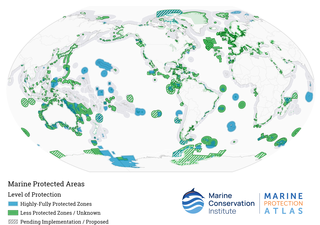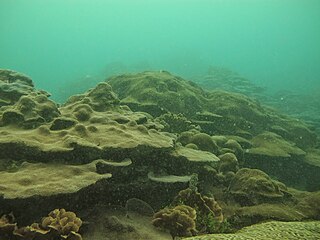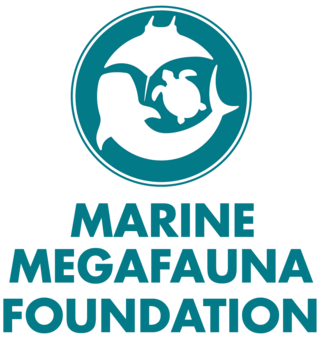
Dr. Sylvia Alice Earle is an American marine biologist, oceanographer, explorer, author, and lecturer. She has been a National Geographic Explorer at Large since 1998. Earle was the first female chief scientist of the U.S. National Oceanic and Atmospheric Administration, and was named by Time Magazine as its first Hero for the Planet in 1998.

The Flower Garden Banks National Marine Sanctuary (FGBNMS) is a United States National Marine Sanctuary located 100 nautical miles (190 km) offshore of Galveston, Texas, in the northwestern Gulf of Mexico. It contains the northernmost coral reefs in the United States.

Marine protected areas (MPA) are protected areas of the world's seas, oceans, estuaries or in the US, the Great Lakes. These marine areas can come in many forms ranging from wildlife refuges to research facilities. MPAs restrict human activity for a conservation purpose, typically to protect natural or cultural resources. Such marine resources are protected by local, state, territorial, native, regional, national, or international authorities and differ substantially among and between nations. This variation includes different limitations on development, fishing practices, fishing seasons and catch limits, moorings and bans on removing or disrupting marine life. In some situations, MPAs also provide revenue for countries, potentially equal to the income that they would have if they were to grant companies permissions to fish. The value of MPA to mobile species is unknown.

Golfo Dulce is a gulf in Costa Rica, located at the south of the Province of Puntarenas. The inlet starts on the Pacific Ocean side of Costa Rica and extends slightly northward before turning west. The most westward part is at the city of Rincon. The bay separates the Osa Peninsula from the mainland Costa Rica.

Rivière Noire or Black River is a district on the western side of the island of Mauritius. Rivière Noire translates to Black River. This region receives less rainfall than the others. The district has an area of 259 square kilometres (100 sq mi) and the population was estimated to be 80,939 as of 31 December 2015. It is the third largest district of Mauritius in area, but the smallest in terms of population. The district is mostly rural, but it also include the western part of the city of Port Louis and western part of Quatre Bornes.

North Island is the northernmost island in the Houtman Abrolhos, a coral reef archipelago in the Indian Ocean off the coast of Mid West Western Australia. Located about 14 km (9 mi) from the nearest island group, it is one of the largest islands in the Houtman Abrolhos, and one of the few to support dune systems. It has relatively diverse flora dominated by chenopod shrubs and fauna that includes the introduced tammar wallaby, around seven species of reptile, and about 15 resident bird species.

The Southwest Shelf Transition, also known as the Houtman marine ecoregion, is a biogeographic region of Australia's continental shelf and coastal waters. It includes the subtropical coastal waters of Southwest Australia.

The following outline is provided as an overview of and introduction to Oceanography.

Cephalopholis miniata, also known as the coral grouper, coral hind, coral rock cod, coral cod, coral trout, round-tailed trout or vermillion seabass is a species of marine ray-finned fish, a grouper from the subfamily Epinephelinae which is in the family Serranidae which also includes the anthias and sea basses. It is associated with coral reefs and occurs in the Indo-Pacific.
Defying Ocean's End (DOE) is a global agenda for action in marine conservation compiled in a 2004 Island Press book. It is also the title of a 2003 Los Cabos (Mexico) conference, where the agenda was formulated.

East Wallabi Island is an island in the Wallabi Group of the Houtman Abrolhos, located in the Indian Ocean off the west coast of mainland Australia.

The Phoenix Islands Protected Area (PIPA) is located in the Republic of Kiribati, an ocean nation in the central Pacific approximately midway between Australia and Hawaii. PIPA constitutes 11.34% of Kiribati's exclusive economic zone (EEZ), and with a size of 408,250 km2 (157,630 sq mi), it is one of the largest marine protected areas (MPA) and one of the largest protected areas of any type on Earth. The PIPA was also designated as the world's largest and deepest UNESCO World Heritage Site in 2010.
Marine Conservation Institute is a tax-exempt nonprofit ocean conservation organization working to identify and protect vulnerable ocean ecosystems worldwide. The organization is headquartered in Seattle, Washington, with offices in Washington, D.C., and Glen Ellen, California.
Acropora abrolhosensis is a species of acroporid coral that was first described by John Veron in 1985. Found in sheltered lagoons and shallow reefs, it is listed as a vulnerable species on the IUCN Red List. The population of the species is decreasing, and most specimens are found in Western Australia, but occurs in many other areas. It is also listed under CITES Appendix II.

The Great Southern Reef is a system of interconnected reefs that spans the southern coast of continental Australia and Tasmania and extends as far north as Brisbane to the east and Kalbarri to the west. It covers 71,000 km2 (27,000 sq mi) of ocean and straddles five states, running along the coast for 8,000 km (5,000 mi).

Coral Reef of Varadero is a coral reef located in the Bay of Cartagena, Colombia. Its paradoxical existence, harboring high coral cover and diversity despite the poor water quality and high sediment loads discharged into the Bay for the last 500 years by the Canal del Dique, has drawn special interest by the scientific community as well as local and international media. The persistence of Varadero reef is currently threatened by a project to modernize Cartagena’s port, which includes the dredging of a new shipping lane through the reef. The regular operation and maintenance of the channel is also likely to cause water quality in the Bay to deteriorate.

The Marine Policy of the Barack Obama administration comprises several significant environmental policy decisions for the oceans made during his two terms in office from 2009 to 2017. By executive action, US President Barack Obama increased fourfold the amount of protected marine space in waters under United States control, setting a major precedent for global ocean conservation. Using the U.S. president's authority under the Antiquities Act of 1906, he expanded to 200 nautical miles the seaward limits of Papahānaumokuākea Marine National Monument in Hawaiʻi and the Pacific Remote Islands Marine National Monument around the U.S. island possessions in the Central Pacific. In the Atlantic, Obama created the Northeast Canyons and Seamounts Marine National Monument, the first marine monument in the U.S. exclusive economic zone (EEZ) in the Atlantic.

Cephalopholis sonnerati, known as the tomato hind, tomato rockcod, or tomato cod, is a species of marine ray-finned fish, a grouper from the subfamily Epinephelinae which is in the family Serranidae which also includes the anthias and sea basses. It is distributed on coral reefs in the tropical Indo-Pacific. It is also sometimes called the orange-spotted cod, red coral cod, red rockcod, tomato grouper, or tomato seabass.

The Coral reefs of Kiribati consists of 32 atolls and one raised coral island, Banaba, which is an isolated island between Nauru and the Gilbert Islands. The islands of Kiribati are dispersed over 3.5 million km2 (1.4 million sq mi) of the Pacific Ocean and straddle the equator and the 180th meridian, extending into the eastern and western hemispheres, as well as the northern and southern hemispheres. 21 of the 33 islands are inhabited. The groups of islands of Kiribati are:

The Marine Megafauna Foundation (MMF) is a marine biology research and conservation nonprofit known for discovering, researching, and protecting large marine animals including whale sharks, manta rays, sea turtles, whales, and dugongs.
















